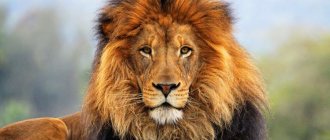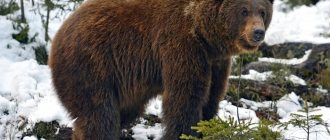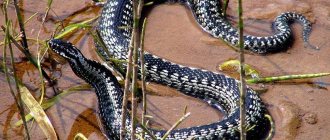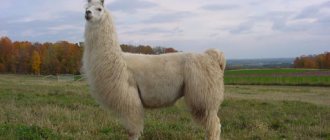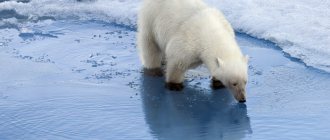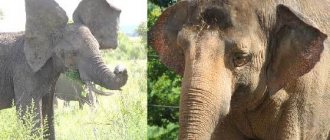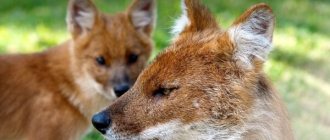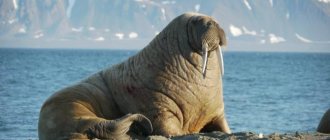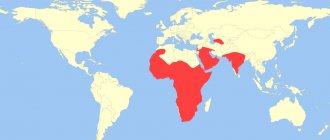- Wild animals
- >>
- Mammals
The sea lion is one of six species of eared seals, found primarily in the waters of the Pacific Ocean. Sea lions are characterized by short, coarse fur that lacks a distinct undercoat. With the exception of the California sea lion (Zalophus californianus), males have lion-like manes and constantly roar to protect their harems.
Origin of the species and description
Photo: Sea Lion
Found along the west coast of North America, the California sea lion is a common seal, differing only slightly in size and ear shape. Unlike true seals, sea lions and other eared seals are able to rotate their hind fins forward, using all four limbs to move on land. Sea lions also have longer flippers than true seals.
The animals have large eyes and coat color ranging from pale to dark brown. The male reaches a maximum length of about 2.5 meters and a weight of up to 400 kg. The female grows up to 1.8 meters and 90 kg. In captivity, the animal can live more than 30 years, in the wild it is much shorter.
Australian
The Australian, or white-capped, species previously lived in an area spanning the south of the mainland and up to Tasmania. These sea lions are similar in size to their southern counterparts. However, they have fundamental differences in appearance depending on gender: for example, females have a silver-gray or light brown tint, more saturated on the back. Males have thicker colors. The brown tint immediately visually distinguishes them within the colony.
Appearance and features
Photo: What a sea lion looks like
The front flippers of sea lions are strong enough to support the animal on land. They also help regulate the sea lion's body temperature. When it's cold, specially designed blood vessels in the thin-walled flippers constrict to prevent heat loss. When it's hot, blood flow to these areas of the body surface increases to help the animal cool down faster.
In Californian waters, you can often see a strange group of dark “fins” sticking out of the water - these are sea lions trying to cool their bodies.
The sea lion's sleek body is ideal for diving up to 180 meters into the ocean in search of tasty fish and squid. Because sea lions are mammals and must breathe air, they cannot stay underwater for long. With nostrils that automatically close when diving, the sea lion usually remains underwater for up to 20 minutes. Lions have ear flaps that they can turn with the opening down to prevent water from getting into their ears when swimming or diving.
Video: Sea Lion
The reflective membrane at the back of the eye acts like a mirror, reflecting what little light they find in the ocean. This helps them see underwater where there may be little light. Sea lions have excellent senses of hearing and smell. The animals are good swimmers, reaching speeds of 29 km/hour. This helps them escape from enemies.
It can be quite dark in the deep ocean, but sea lions find their way using their sensitive whiskers. Each long barbel, called a vibrissa, is attached to the sea lion's upper lip. The antenna rotates from underwater currents, allowing the sea lion to “feel” any food floating nearby.
Nutrition
The basis of the diet of these mammals are animals such as crustaceans, mollusks and some types of small fish. The very dexterous and resourceful body of the sea lion makes it an excellent hunter - it very quickly and quickly pursues its prey, and then enjoys the process of eating it.
Where does the sea lion live?
Photo: Animal sea lion
Sea lions, seals and walruses are part of the scientific group of animals called pinnipeds. Sea lions and seals are marine mammals that spend most of the day in the ocean searching for food.
They all have fins at the end of their limbs to help them swim. Like all marine mammals, they have a thick layer of fat to keep their bodies warm in the cold ocean.
Sea lions live along the entire coastline and islands of the Pacific Ocean. Although most of the sea lion population in the Galapagos Islands is concentrated in the waters surrounding the Galapagos archipelago, where humans have established a permanent colony off the coast of Ecuador.
Sea lion in the Red Book
Steller's northern sea lion is listed in category EN A1b (near threatened) on the International Union for Conservation of Nature (IUCN) Red List.
In Russia, the animal is included in the second category of rarity, as the only species in the genus whose numbers are steadily declining for unclear reasons.
Main causes of extinction
Factors that influenced the decline in the number of pinnipeds:
- hunting, which was only banned in 1990;
- illegal shooting by fish farm owners;
- injury from fishing gear (trawls, longlines, nets);
- exploration of natural resources;
- pollution of coastal areas with oil and heavy metals;
- natural enemies, diseases.
A sharp decrease in the population occurred due to the fact that animals were exterminated en masse by the natives for meat, fur, and fat. Steller sea lions were shot to preserve fish numbers.
Scientists suggest that increasing competition for food and a decrease in the volume of prey, leading to a lack of nutrients, play a significant role in the extinction.
Current population situation
The exact reasons for the decline in the number of sea lions have not yet been established, but since the 60s. last century it continues to decline. In Russia, the population of sea lions has decreased from 50 to 12 thousand. Every year, 5% fewer pups are born.
Monitoring by scientists at the Komandorsky Nature Reserve showed that in the 70s. of the last century, 12 thousand individuals spent the winter on the islands, and 5 thousand individuals in the summer. Over the last decade, more than 500 animals per season have not been recorded.
The same situation has developed in Alaska, where the number of mammals has decreased by at least half. And on the islands of the Aleutian chain the population has decreased by 80%.
On the Kuril Island of Tyuleniy, about a thousand puppies are born annually, which gives an increase of 5%. Scientists attribute this fact to climate change and the good environmental situation in the Sea of Okhotsk. But it will take more than a decade to restore the total number.
Are protective measures required?
Animal rights activists recommend:
- strengthening the protection of reproductive rookeries in the Komandorsky and Kronotsky nature reserves, reducing the number of arctic foxes;
- studying behavior, monitoring rookeries using camera traps;
- carrying out explanatory work with the population of Nevelsk and Petropavlovsk-Kamchatsky.
In the Nevelsky district of the Sakhalin region, the Steller Sea Lion Protection Fund has been created, which responds to signals of scaring away sea lions and, together with the local administration, clears bedding areas.
Rospotrebnadzor for the Kamchatka Territory proposed to approve a special shipping regime from October to May, clean up Avacha Bay, protect pinniped habitats from stray dogs and install web cameras.
What does a sea lion eat?
Photo: Sea lion in the wild
All sea lions are carnivores, eating fish, squid, crabs or shellfish. Sea lions can even eat seals. Mammals do not eat in reserve, like brown bears, for example, but eat every day. Sea lions do not have problems with access to fresh food.
Favorite treat:
- herring;
- pollock;
- capelin;
- halibut;
- bulls;
- flounder.
Most food is swallowed whole. The animals throw the fish up and swallow it. Animals also eat bivalves and crustaceans.
Security measures
At the beginning of the 19th century, sea lions were hunted for fat on the California coast. The fat of the killed animals was cut into pieces and rendered. By melting the fat of three sea lions, they got a whole barrel of fat. Their skins were used to make glue. At present, sea lions are of little commercial importance. They are often kept in zoos, circuses and aquariums. Thanks to their intelligence and penchant for games, animals have become favorites of children and adults.
Currently, the number of sea lions everywhere is small: off the coast of California and Mexico there are 50 thousand individuals, and off the Galapagos Islands - about 40 thousand, in the waters of Japan - only 200-500 individuals (Scheffer, 1958). According to Nishiwaki (1972), the Japanese subspecies Z. californianus japonicus Peters, 1866 appears to have disappeared completely.
Sea lions are included in the Red Book. They are under protection, thanks to which their numbers have stopped declining.
Video
Features of character and lifestyle
Photo: Sea lion catching fish
The sea lion is a coastal animal that often leaps out of the water while swimming. A fast swimmer and excellent diver, but dives can last up to 9 minutes. Animals are not afraid of heights and can safely jump into the water from a cliff 20-30 meters high.
The maximum recorded diving depth is 274 meters, but this is clearly not a limit. Sea lions love to congregate on man-made structures.
Interesting fact
Sea lions and penguins are connected by an interesting fact witnessed in 2006. Cases of sexual intercourse between these representatives of different animal species have been recorded. Experts considered this fact to be an accident. However, after some time, several more cases were noted, and the gender of the penguin did not make any difference. The lion simply pressed the bird with his weight and did his job. After the process was completed, the predator released the victim. But there was one recorded case where the penguin was subsequently eaten.
Social structure and reproduction
Photo: Sea lion pup
Occurs in large herds, males have harems of 3 to 20 females. Brown puppies are born after 12 months of pregnancy. Males do not eat at all during the breeding season. They are more concerned with protecting their territory and making sure their females do not run off with another male. Despite their adaptation to aquatic life, sea lions are still confined to land for breeding.
Typically the males, called bulls, are the first to leave the water to establish territory on the ice or rocks. Bulls prepare for each breeding season by consuming extra food to build up an especially thick layer of fat. This allows the individual to live for weeks without food as it protects its territory and females. During the breeding season, bulls bark loudly and continuously to defend their territories. Bulls shake their heads threateningly or rush at any opponent.
There are several times more bulls than adult females, which are called cows. During the breeding season, each adult bull tries to gather as many cows as possible to form his “harem”. Sea lion harems, or family groups, can number up to 15 cows and their young. The bull watches over his harem, protecting it from harm. A large group of animals gathered together on land or on drifting ice is called a colony. During lambing, these areas are known as rookeries.
The exception to this behavior is the Australian bull sea lion, it does not establish a territory or form a harem. Instead, the bulls fight for any available female. Males make all sorts of sounds: barking, honking, trumpeting or roaring. A young lion, called a cub, can find its mother from hundreds collected on rocky shores by the sound it makes. A few days or weeks after the bulls have established themselves on the beaches and cliffs, the females come ashore to join them.
Each male tries to drive as many nesting females into the harem as possible. Those females who conceived a year ago arrive last, gathering on land to give birth to their pup.
Females give birth to one puppy per year. Puppies are born with their eyes open and feed on their mother's milk from the first days of life. Milk has a high fat content, which helps the puppy quickly build up a thick layer of subcutaneous fat to keep warm. Puppies are born with a long, thick coat of hair called lanugo, which helps keep them warm until they develop their own body fat. Mothers are very attentive to their pups during the first 2-4 days of life, sniffing and tugging at their necks. Puppies are able to swim awkwardly at birth and can walk a little.
Behavior
The entire life of sea lions is connected with the sea, although they spend quite a lot of time on land. Outside the mating season, young animals and adult males migrate north, and females with cubs migrate south or simply remain at their native rookeries. Moreover, the latter form more numerous groups. On land, sea lions sleep for a long time, huddled in tight rookeries. Having woken up, the animals devote their free time to caring for their fur. They take obvious pleasure in grooming themselves with the claws of their hind limbs or simply rubbing themselves against stones or the side of a nearby comrade.
Sea lions move quite briskly on land, leaning on their hands and back of their feet, vigorously swinging their neck and head in different directions. This method of transportation allows you to move at speeds of up to 30 km/h over short distances. In water they easily reach speeds of up to 40 km/h.
Sea lions use their front flippers to row like oars, and their hind limbs serve as rudder. They often swim bending their whole body, sometimes disappearing under the water, sometimes emerging to the surface. They prefer to hunt in splendid isolation, although if necessary they also organize group hunts. Group hunting begins when a large school of fish or squid appears.
The diet is based on fish (salmon and herring), squid and octopus. The sea lion pulls large prey to the surface and eats it piece by piece, while small prey is simply swallowed under water. It usually stays under water for about 3 minutes, but can remain up to 15 minutes, diving to a depth of up to 270 m.
Natural enemies of sea lions
Photo: What a sea lion looks like
Sea lions have three main and dangerous enemies. These are killer whales, sharks and people. Humans pose the greatest threat to them, both in water and on land, than all other predator species. While no one knows too much about lions' interactions with carnivorous whales or sharks, we certainly do know about negative interactions with humans.
Many researchers believe that the sea lion can swim faster than the killer whale and great white shark. But lions often become victims of these predators. Young or sick individuals cannot move fast enough, so they are the easiest to catch.
Sea lions can often sense when killer whales or sharks are nearby. Their greatest defense against predators is to get to the water's edge and get to land where the lions are out of reach of marine predators. Sometimes sharks even manage to deftly jump out of the water and capture prey right on the shore if the lion has not moved far enough from the water’s edge.
Human interaction
Steller sea lions are practically not accustomed to captivity; they are wary and even hostile towards people. But there are three unique cities in the world where pinnipeds coexist peacefully with humans. One of them is American Seattle. The other two are Sakhalin's Nevelsk and Petropavlovsk-Kamchatsky, located in the Russian Far East.
In Nevelsk, after the earthquake, excursionists can approach the rookery only by boats and motorboats; in Petropavlovsk-Kamchatsky, to the fish factory pier - by water and from the shore.
Volunteers carry out educational work for excursionists. Information boards with a description of the species have been installed. People can see sea lions not in a zoo, but in natural conditions.
The culture of non-interference will never take root in Russia. Despite the posted signs prohibiting feeding the animals, every second tourist tries to treat them with fish. To take photos, people come close to the rookery, disturbing the peace of timid sea lions.
Population and species status
Photo: Animal sea lion
Five genera of sea lions, along with fur seals and northern fur seals, make up the family Otariidae (eared seals). All fur seals and sea lions, along with walruses, are grouped as pinnipeds.
There are six different species of sea lions:
Northern sea lion.
This is the largest animal. An adult male is usually three times larger than females and has a thick, hairy neck similar to a lion's mane. Colors range from light brown to reddish brown.
This is the largest lion of the eared seals. Males are up to 3.3 meters long and weigh 1 ton, while females are about 2.5 meters long and weigh less than 300 kg. Due to their enormous size and aggressive nature, they are rarely kept in captivity.
It lives along the coast of the Bering Sea and on both sides of the North Pacific Ocean.
Habitat:
- Coast of central California;
- In the Aleutian Islands;
- Along the coast of eastern Russia;
- The southern coast of South Korea, as well as to Japan.
California sea lion.
The brown animal is found on the coasts of Japan and Korea, in western North America from southern Canada to the middle of Mexico and on the Galapagos Islands. These are very intelligent animals that are easy to train, which is why they often live in captivity.
Galapagos sea lion.
Slightly smaller than the Californian, it lives in the Galapagos Islands, and also closer to the coast of Ecuador.
Southern or South American sea lion.
This species has a shorter and wider snout. Southern breeds have a dark brown body color with a dark yellow belly. Found along the west and east coasts of South America and the Falkland Islands.
Australian sea lion.
Adult males have a yellowish mane on a dark brown body. The population is distributed along the western and southern coasts of Australia. Found along the southern coast of Western Australia to South Australia. Adult males are 2.0-2.5 meters long and weigh up to 300 kg, females are 1.5 meters long and weigh less than 100 kg.
Hooker's sea lion, or New Zealand sea lion.
It has a black or very dark brown color. Size smaller than Australian. Found along the New Zealand coastline. The New Zealand sea lion is in danger of becoming extinct. Males are 2.0-2.5 meters long, females are 1.5-2.0 meters long. Their weight is slightly less than that of Australian sea lions.
harbor seal
Angelfish (clam)
(Phoca vitulina) is often found off the sea coasts of temperate regions of the Northern Hemisphere. It never swims far from land and sometimes settles in fresh lakes and large rivers.
This is a relatively small animal. The body length of an adult male is approximately 1.5 m and weight is 45 kg; the female is about the same. The head is round, the eyes are large, the muzzle is as if chopped off, the body is stocky, with a short neck. The color varies from yellowish-gray with dark brown spots to almost black with white spots.
The harbor seal does not form large colonies; it spends more time on the shore than other seals and cannot sleep in the water. Families consisting of a male, several females and their cubs of different ages often use the same place for overnight stays, which becomes their group territory. These are very friendly animals that are easy to tame.
Cubs (sometimes twins) are born in early spring. Newborns of the Far Eastern form are covered with fluffy white fur that lasts for 3–4 weeks (the pup stage). In other forms, this fur sheds immediately, sometimes even before birth. The baby's cry resembles the bleating of a lamb. His mother feeds him for about 5 weeks, after which he learns to forage for food himself. The common seal feeds on a variety of fish (capelin, navaga, herring, flounder, pollock, etc.), as well as squid and octopus.
The species' range extends along both Atlantic coasts from southern New Jersey and the northern Mediterranean to the polar ice boundary, and along the Far Eastern and American coasts of the Pacific Ocean - from Kamchatka in the north to Baja California in the south.
The Ungave subspecies of the common seal (Pv mellonae) lives only in Upper Seal and Lower Seal lakes (translated as Upper and Lower Seal) 150 km east of Hudson Bay. How it penetrated these inland bodies of water remains a mystery; perhaps their settlement occurred during the retreat of the glacier.
